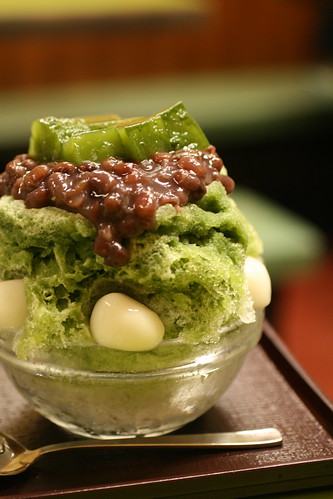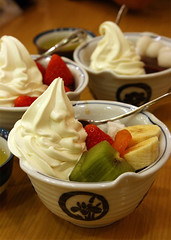Japanese dessert pictures - pictures of Japanese sweets and Japanese cakes.
japanesefood.about.com/library/pictures/blpicdes_index.htm
Japanese Desserts and Japanese Sweets - Information on Japanese
Japanese desserts and Japanese sweets recipes - includes green tea desserts.
http://japanesefood.about.com/od/japanesedessertsweet/Japanese_Desserts_Sweets.htm
Japanese Desserts
Anmitsu is a Japanese dessert that has been popular for many decades. It is made of small cubes of agarjelly, a white translucent jelly made from red algae or seaweed. It is served in a bowl with sweet azuki bean paste or anko, boiled peas, and a variety of fruits such as peach slices, pieces of pineapples, and cherries.
Anpan is a Japanese sweet bun filled with red bean paste
Castella is a popular Japanese sponge cake made of sugar, flour, eggs and starch syrup, very common at festivals and as a street food
Chinsuko is a traditional sweet It is a small biscuits made of mostly lard and flour, with a mild and sweet flavor
Imagawayaki is a Japanese dessert that is made of batter in a special pan, and filled with sweet azuki bean paste
Melonpan also known as Melon pan, Melon buns or Melon bread, are inexpensive, sweet bakery products popular in Japan, Taiwan, and China made from an enriched dough covered in a thin layer of crispy cookie dough
Mochi ice cream is a Japanese confection made from moshi (pulverized sticky rice) with an ice cream filling
Sātā andāgī are sweet deep fried buns of dough similar to doughnuts, native to Okinawa
Wagashi is a traditional Japanese confectionary which is often served with tea, especially the types made of moshi, azuki bean paste, and fruits.
info credit: http://dessertsbykylie.wordpress.com/japanese-desserts/
......................................................................................................................................................
Although dessert is not included in the average traditional meal (especially at our house) and Kaiseki restaurants include a small piece of fruit (if anything) to end the meal, traditional sweets, called wagashi, have a long tradition. These were usually consumed with tea, or as a snack in the middle of the day. Wagashi companies such as Toraya have been in business since at least the 16th century, supplying, among others, the Imperial court. Their wagashi (pictured above) are beautiful to behold, and feature seasonal ingredients, motifs and flavors. They are also quite prestigious and expensive ($4 and up) and are often wrapped in exquisite boxes to be given as gifts, or served to guests during tea ceremonies. There are different grades of wagashi, and some are much more humble and affordable. Most people don’t make their own wagashi, as they are time consuming and difficult to make. In the West, ohagi are found at Japanese markets in the refrigerated section. For fun, or to feed a large group, you might try making your own ohagi, or one of the desserts featured below.
 Anko (sweet bean paste)
Anko (sweet bean paste)This is the chocolate brown sweet bean filling that is encased in ohagi (glutinous rice cakes), anpan (rolls), dorayaki (mini pancakes), etc. While it is available in cans, it is very easy to make, and economical as well. As desserts go, it’s relatively healthy because the main ingredient is azuki bean. While it does have a lot of sugar, it has no fat and no dairy products.
 Ohagi (glutinous rice cakes)
Ohagi (glutinous rice cakes)These rice cakes are a little time consuming, but if you are serving a large crowd and want a real traditional dessert, this is a good option. It would also be a fun group or family activity. The home made quality of this type of ohagi is celebrated, so it is not important to make them look perfect. The photo is from my first attempt, served during our family’s Oshogatsu New Year celebration. They were quite lumpy and homely, but they tasted great.
 Dorayaki (mini pancakes filled with bean paste)
Dorayaki (mini pancakes filled with bean paste)Children of all ages love these sweet pancake sandwiches filled with sweet bean paste. The name comes from the Japanese word for gong, which they resemble. This is a very easy recipe if you already have the bean paste made. Dorayaki are delicious hot, but they are usually eaten at room temperature with tea. They can be wrapped in wax paper to preserve their moisture.Anmitsu (Japanese style sundae) and Mitsumame
Tea houses and coffee shops all over Japan serve this traditional sweet snack, and it’s one of my mom’s favorites. A similar dessert is served at Chinese restaurants. Small cubes of translucent kanten are served with sugar syrup and a few pieces of canned fruit. Deluxe versions also add a scoop of anko (bean paste) and for super deluxe, vanilla ice cream cover with some matcha syrup. The visual effect is colorful and festive, and the taste is refreshing and not as heavy as a western sundae.
 Kurikinton (pureed sweet potato with candied chestnuts)
Kurikinton (pureed sweet potato with candied chestnuts)While not technically a dessert, this sweet concoction of creamy satsuma-imo (Japanese sweet potatoes) and candied chestnuts is served as part of the traditional Oshogatsu New Year's osechi-ryori feast. The intense flavor of the chestnuts marries well with Japanese sweet potatoes, which have a similar flavor. It's important to use satsuma-imo, not regular, sweet potatoes, for this dish. For more information, read the vegetable page in the ingredient section. The name, "chestnut gold puree" is the epitome of richness, and its bright gold color symbolizes wealth.
images/info credit: http://www.savoryjapan.com/recipes/dessert/dessert.html
......................................................................................................................................................
Cooks.com - Recipes - Japanese Dessert
PERSIMMON DESSERT: Puree in blender 2 Japanese persimmons. Add sugar and salt. Turn into bowl and add remaining 4 ingredients. Mix and chill before serving. ...
http://www.cooks.com/rec/search/0,1-0,blender_desserts,FF.html
Japanese Dessert *-* « +*+*+ B.K & Ocornerz's Weblog +*+*+
6 ม.ค. 2009 ... Japanese Dessert *-* …ในที่สุดก็ได้กิน… หลังจากที่อยากกันมานาน เลยขอไปลองชิมของ OTOYA (พารากอน) ... 2 Responses to “Japanese Dessert *-*” ...
ocornerz.wordpress.com/2009/01/06/japanese-dessert/
Japanese Food - Prepared Dishes, Desserts & Drinks
Anmitsu - Japanese Traditional Dessert · Kakigori - Japanese Shaved Ice Dessert · Uiro - Japanese Sweet Rice Cake · Oshiruko - traditional Japanese dessert ...
www.japan-101.com/food/index2.htm
Category:Japanese desserts and sweets - Wikipedia, the free
10 May 2009 ... This category contains Japanese desserts and sweets. See also Category:Wagashi about traditional Japanese sweets. ...
http://en.wikipedia.org/wiki/Category:Japanese_desserts_and_sweets
Press Release: Sweet Anticipation…Irresistible Japanese Desserts ...
25 ก.ย. 2009 ... Sweet Anticipation…Irresistible Japanese Desserts at Kisso Japanese Restaurant The Westin Grande Sukhumvit, Bangkok October at Kisso is a ...
http://www.thaipr.net/nc/readnews.aspx?newsid=89A9C7749C6B76C1633F9C8CBCB346EE&query=S2lzc28=
Authentic Japanese Dessert Recipes
Authentic Japanese dessert recipes make delicious Japanese candy treats. Try these old-fashioned Japanese dessert recipes today!
www.homemade-dessert-recipes.com/japanese-dessert-recipes.html
Japanese Desserts? - japan-guide.com forum
Are there any Japanese desserts? Our Book club wants to serve food to loosely follow theme of Memoirs of a Geisha and don't know what to serve, besides tea. ...
www.japan-guide.com/forum/quereadisplay.html?0+13194
How To Make Japanese Desserts | How To Do Things.com
Japanese desserts are known to be nutritious and delicious. In this article you will find recipes for three types of Ohagi, or sweet rice cake, ...
http://www.howtodothings.com/uncategorized/a1656-how-to-make-japanese-desserts.html
Japanese Foods, Japanese Restaurants, Japanese Recipes, Japanese Cuisines, Japanese Desserts, Japanese Cooking, Japanese Vegetarian Food, Japanese Spices, Gourmet, Japanese Soup, Japanese Beverage, Japanese Drink, Japanese Ingredient, เมนูอาหาร, อาหารญี่ปุ่น, ร้านอาหารญี่ปุ่น, สูตรอาหารญี่ปุ่น, อร่อย, ปรุงอาหาร, วิธีทำอาหาร, ทำอาหารญี่ปุ่น, อาหารประจำชาติ ญี่ปุ่น, ขนม, เครื่องดื่ม











